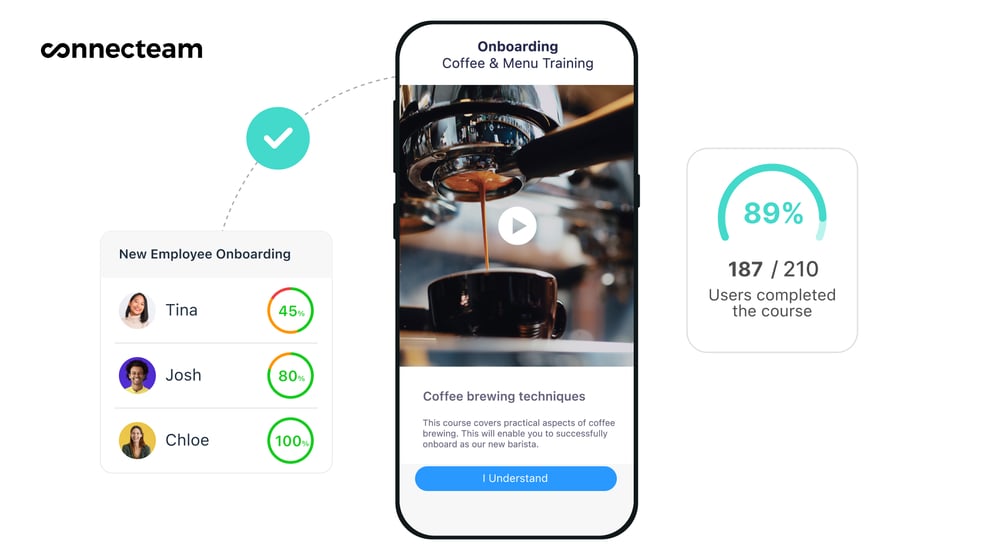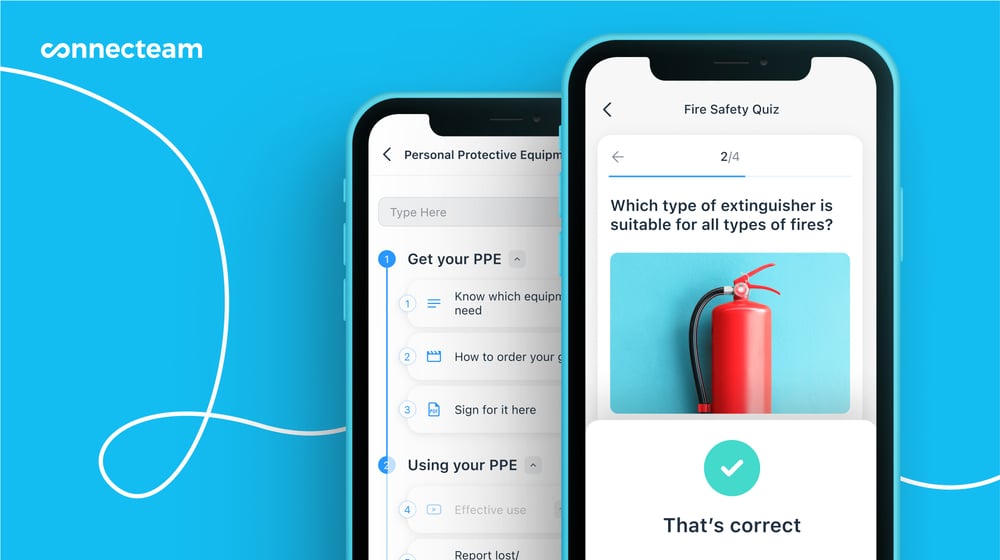Defining and adopting realistic training objectives helps you deliver better training and get closer to achieving your overall goals. In our how-to guide, we show you how to set realistic employee training objectives.
Key Takeaways
- Training goals are often vague or subjective, making it difficult to plan achievable steps that move toward the goal.
- Clear training objectives focus on specific improvements that benchmark training program success.
- Realistic training objectives should be easy to understand, relevant to employees’ needs, measurable, and attainable.
- Adopting realistic training objectives can improve employee focus, productivity, and morale while decreasing overall training time.
Setting realistic employee training objectives can be a challenge—but relying on poorly defined or unrealistic objectives sets your training programs up for failure. They can become wasted efforts that fail to deliver real results. This not only frustrates your employees, but it also hampers productivity, wastes money, and gets you further from your business goals.
But with the right knowledge and skills at your disposal, you can define and adopt achievable employee training objectives. These will help you plan and deliver training more effectively. In the long run, they also save you money and improve employee performance and retention.
In this article, we explore what training objectives are, why they’re beneficial, and how to set objectives that make a difference. We’ve also included a list of employee objective examples to help get you started.
What Are Training Objectives?
Training goals vs. training objectives
To really understand training objectives, it’s important to first define training goals and how training goals and objectives differ.
Training goals are the overall purpose of a training program. Training objectives are the specific and measurable steps that will help achieve those goals. Goals are the big picture, while objectives are the smaller, more detailed steps that must be taken to reach that big picture.
The purpose of training objectives is to communicate to trainees what they’re expected to learn at each stage and why that information is important. They also provide clear measures of progress. These can be used to evaluate training success and pinpoint areas for future improvement.
Without strong training objectives, trainees are less likely to meet their training goals.
Some examples of training goals include:
- Improve workplace safety
- Enhance employee leadership skills
Some examples of training objectives include:
- After a 1-hour training session, workers will know where all fire extinguishers are located at the job site and will be able to operate them properly.
- Across a 2-day training course, senior employees will learn how to help each of their team members set 3 realistic goals.
What makes a training objective realistic?
Training quickly loses momentum when objectives are vague or out of reach for trainees. Thus, realistic training objectives are easy to understand and relevant to employees’ needs.
They must also be measurable and attainable. A measurable objective defines what training should achieve at each step. An attainable objective takes into account reasonable learning time and considers obstacles trainees may encounter.
Benefits of Setting Realistic Employee Training Objectives
Realistic objectives are key to reaching business goals. In addition, they improve the overall learning and development process and can generate improvements across the employee experience. Beyond that, they can help you:
Avoid overwhelming employees
By breaking down training into meaningful objectives, you provide employees with a step-by-step process that’s less overwhelming. Instead of thinking about the entire training journey at once, employees can focus on one piece of training at a time.
Decrease training time and keep employees focused
Creating training objectives can decrease training time, as both employees and trainers know what’s expected of them and what the purpose of training is. When they’re focused on a clear and measurable outcome, they’ll waste less time doing guesswork and more time completing training.
Likewise, defining clear objectives makes it easier for employees to understand the purpose and expected outcome of training. This way, they’ll stay focused on learning.

Improve employee morale and reduce turnover
Setting realistic training objectives can help improve employee morale and reduce turnover by giving employees a clear path for growth and development within the organization. And when you provide career development opportunities to your workers, they feel more motivated to do well and thus become more engaged.
Increase productivity and motivation
Effective training and development provides employees with the necessary skills and knowledge to perform their tasks more efficiently, resulting in better performance, motivation, andhigher productivity.
Did You Know?
People with goals and objectives are 10 times more likely to succeed, and this applies to the workplace, too. Setting objectives helps your team understand the why behind their tasks, increasing their motivation and producing better results.
Calculate training value
Clear objectives provide an easy way to measure the success of the training program. When objectives are met, it demonstrates that the training has delivered the desired outcomes and provided value to the organization.
Similarly, establishing objectives makes it possible to pinpoint where training has succeeded, and where it needs to be improved or adjusted.
Empower trainers
Giving trainers clear directives for how they should measure success helps ensure training stays on track. It also helps them provide support to employees in ways most likely to result in the desired outcome.
How To Set Employee Training Objectives
Follow these steps to take your training plan from a statement of vague learning outcomes and learning goals to a plan with clear objectives.
Define training purpose
Ask yourself, “What should my employees be able to accomplish when they finish training?” Whether it’s demonstrating an understanding of company policies or learning a new system, define the goal for training.
For example, say your company is investing in new project management software and you’ll be training them on how to use it. Thus, the goal would be to ensure trainees know how to properly use the software.
From this goal, set a realistic training objective. This might be, “After completing training, you will be able to open a new project in the software and set project assignments.”
Keep things simple
Objective statements should be short and to the point. Keep your objectives to no more than 1 or 2 highly specific sentences. Avoid vague statements or exaggerated language.
Learning and development professionals rely on the following objectives format:
Time frame + Target audience + Action verb that describes outcome + Necessary details
Here’s an example of this format in action:
“By the end of this week’s (time frame) manager training (target audience), you will be able to conduct (action verb) a performance management meeting with one of your direct reports (necessary details).”
Take a look at psychology
Learning and development strategies are influenced by a long history of psychological study. Two frameworks you should be familiar with when you’re establishing learning objectives for training are SMART goals and Bloom’s Taxonomy.
The SMART framework
SMART stands for specific, measurable, attainable, relevant, and time-bound. Using this framework, you can translate a general training goal into meaningful objectives. This way, you help employees learn more effectively.
For example:
- General goal: “Sales employees will increase sales for the business.”
- SMART objective: “After this 2-day training, sales employees will be able to define the differences between our product and our top 3 competitors.”
The objective above is SMART because it’s:
- Specific. The expected outcome is that trainees will be able to define product differences.
- Measurable. Trainees are expected to define product differences against 3 competitors.
- Attainable. Two days should be enough time to familiarize the trainees with product differences.
- Relevant. The objective relates to the company’s goal of increased sales by ensuring sales staff are familiar with how their product compares to competitors. This knowledge can be used to improve sales pitches.
- Time-bound. Two days of training are allotted.
Bloom’s Taxonomy
Educational psychologist Benjamin Bloom classified learning into 6 categories: knowledge, comprehension, application, analysis, synthesis, and evaluation. These categories are commonly known as Bloom’s Taxonomy. They’ve informed education development and goal-setting practices for over 50 years.
In 2001, a group of psychologists and education experts published a revised category list for Bloom’s Taxonomy. This newer version focuses on action words to define the stages of learning.
The revised stage categories are:
- Remember. At this stage, trainees are tasked with memorizing and recalling facts. Action words for objectives at this stage include: recognize, recall, name, define, and list. For example, “Trainees will be able to list the 3 most common product features.”
- Understand. At this stage, trainees should demonstrate an understanding of the subject. Action words for objectives at this stage include: interpret, classify, summarize, infer, and explain. For example, “Trainees will be able to summarize the company’s policy.”
- Apply. At this stage, trainees can build upon their knowledge by putting it into practical application. Action words for objectives at this stage include: execute, implement, and apply. For example, “Trainees will be able to implement their learning to input Excel formulas.”
- Analyze. At this stage, trainees can critically evaluate their knowledge and compare it to other knowledge sources. Action words for training at this stage include: differentiate, organize, distinguish, and attribute. For example, “Trainees will be able to differentiate between examples of acceptable and bullying conduct in the workplace.”
- Evaluate. At this stage, trainees can form decisions based on their knowledge. Action words for training at this stage include: check and critique. For example, “Trainees will be able to critique sales models and choose the best option for a scenario.”
- Create. At this final stage, trainees can create something new from their knowledge. Action words for training at this stage include: generate, plan, produce, and solve. For example, “Trainees will be able to produce a new marketing plan.”
Identify training obstacles
Ideal conditions rarely exist for training. Whether limited by time, money, or space, you should account for obstacles when defining your objectives. For instance, if time is limited, you may need to prioritize key training objectives and focus on delivering them in a shorter time frame.
Additionally, individual employees may have challenges that impact their learning. It’s important to accurately identify obstacles early so that objectives don’t become unreachable as a result of poor planning. For example, if an employee has a learning disability, it’s important to provide accommodations such as extended time for completing training modules or additional resources.
Some training obstacles can be avoided with modern training platforms. For instance, perhaps in-person training is too costly and difficult to schedule. Instead, offer training on a digital, mobile-friendly platform. Your employees can access training from anywhere and complete it at their own pace.
Connect objectives back to business goals
Assess your training objectives to ensure they relate back to the original business goal. Consider these questions when evaluating objectives:
- Do the stated outcomes support the stated business goal?
- Do the objectives support the overall business mission and values?
- Can employees easily understand how this training will support them in their job?
Revisit these questions after training has been completed to evaluate how well the training met business needs. You can then use this insight to take action and refine your training in the future.
Examples of Realistic Employee Training Objectives
The following examples detail employee training objectives for a variety of common scenarios. Feel free to use these examples to create customized objectives for your unique business goals.
Onboarding new employees
Whether your company conducts virtual onboarding or in-person, make sure to meet the following requirements:
- Employees will be able to access the company’s onboarding platform.
- Employees will upload required documents.
- Employees will be able to name their onboarding buddy and identify how to contact that person.
- Employees will demonstrate an understanding of company policies by completing a quiz.

To learn more about onboarding requirements, read our onboarding checklist.
Improving employee work processes
- Employees will demonstrate an ability to create a new project in the project management software.
- Employees will be able to execute the updated project workflow.
- Employees will be able to successfully clock in and out on their mobile device.
Changing employee workflows can lead to change management struggles. Learn more about effective change management activities to complement your training program.
Developing new skills
- Employees will learn to differentiate between effective and ineffective sales tactics.
- Employees will implement their learning to conduct effective one-to-one meetings with their direct reports.
Improving customer service
- Employees will be able to actively listen to customers, understand their needs, and respond appropriately.
- Employees will be able to console discouraged customers and provide a solution to their problems.
- If an employee cannot solve a customer problem, they will know who to refer them to get resolve the issue.
Pro Tip
Setting up a training program requires careful planning. Read our guide to learn how to start a successful employee training program for tips on doing it properly.
Conclusion
Setting realistic employee training objectives is essential to the success of any organization’s training programs. By defining objectives, organizations can ensure that their training efforts are focused, relevant, and aligned with their business needs. Plus, by following best practices for setting realistic objectives, businesses can ensure their objectives remain achievable and that their efforts don’t go to waste.
There are many other benefits to creating and adopting training objectives. These include increased productivity, improved employee morale and retention, better training value, and more.
This article covers the purpose of training objectives as well as their benefits. It also provides both training goals examples and training objectives examples, and explains the difference between training goals and objectives. You can use the guidelines and examples in this article to develop objectives that are measurable and attainable for your team.




